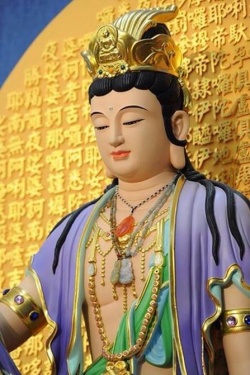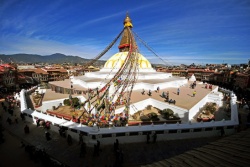Guru Puja (Lama Chopa)
The Guru Puja practice consists of making offerings to and requesting inspiration from the Spiritual Master, seen as the embodiment of the Three Jewels, who is visualised in the form of Lama Tsong Khapa surrounded by the merit field.
Spiritual vows and commitments which might have degenerated are also restored through the practice of the tsog (feast offering).
We unite our minds with the holy mind of the Spiritual Master, who is considered the root and life-force of the spiritual path, to receive blessings to generate realisations on the path to enlightenment.
The word puja literally means "to please", thus Guru Puja means "to please the Gurus, or Spiritual Teachers". Why should we please them? Because they are fully dedicated to helping us develop our inner potential to be enlightened.
In fact, we cannot become enlightened without their skilled guidance, and thus they are more important to us than anyone else.
The idea of "pleasing" our Spiritual Teachers is for our own benefit, not for theirs. We need merit, or positive energy for our enlightened potential to grow and become perfect, and one of the best ways to do that is to make beautiful offerings and prayers to the Three Jewels and to our Spiritual Teachers.
This is what happens in the Guru Puja.
Students are encouraged to sponsor pujas and the greater abundance of offerings creates much good merit which is then dedicated for others.
The puja begins with taking refuge and generating bodhicitta, the intention to become enlightened for the benefit of all beings.
We then visualise the "field of Merit" which includes our present Spiritual Teachers and those of the past, as well as Buddhas, bodhisattvas, arhats, aryas and protectors of the teachings – in short, all the objects of refuge.
Holding this visualization in front of us we offer an extensive version of the seven limb prayer: prostrations, offerings, confessing, rejoicing, requesting, beseeching and dedicating merits.
Following that are prayers requesting inspiration for our Dharma practice, and then a special type of offering called "tsog" (a Tibetan word which means "collection" or "gathering"). Here we offer plates full of fruits and biscuits, which are distributed afterwards to the participants.
The tsog can be eaten by oneself or shared with friends who have faith in the Three Jewels, but should not be given to animals or thrown in a dirty place. Then there are verses requesting inspiration to realize all the stages of the Lam Rim (Graduated Path to Enlightenment).
The puja ends with the dedication of merits to the enlightenment of all beings.
Traditionally, the Guru Puja is celebrated on the 10th and 25th days of the Tibetan calendar. Anyone is welcome to attend, but to receive complete instructions on the practice and its meaning, one must have received initiation into the Highest Yoga Tantra.

